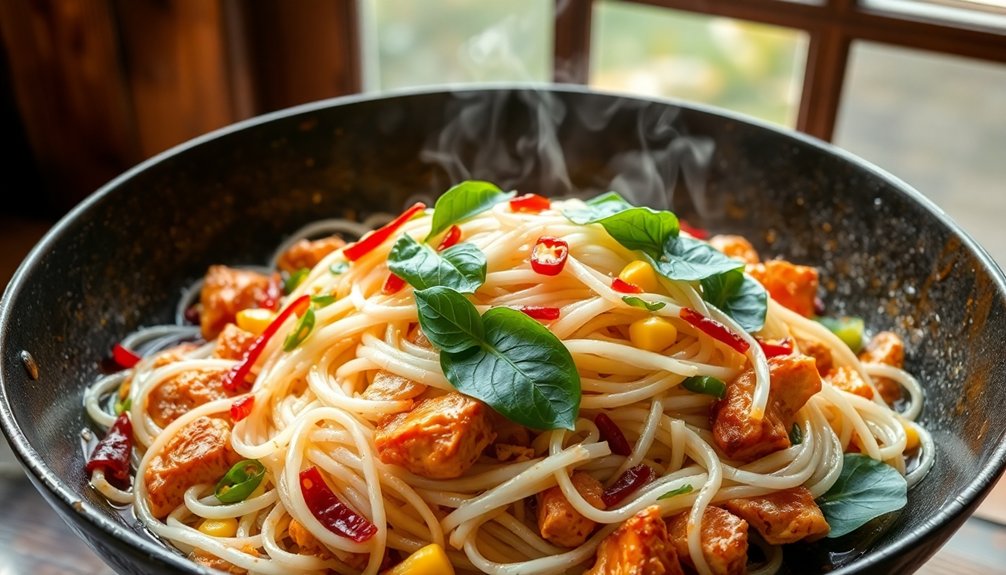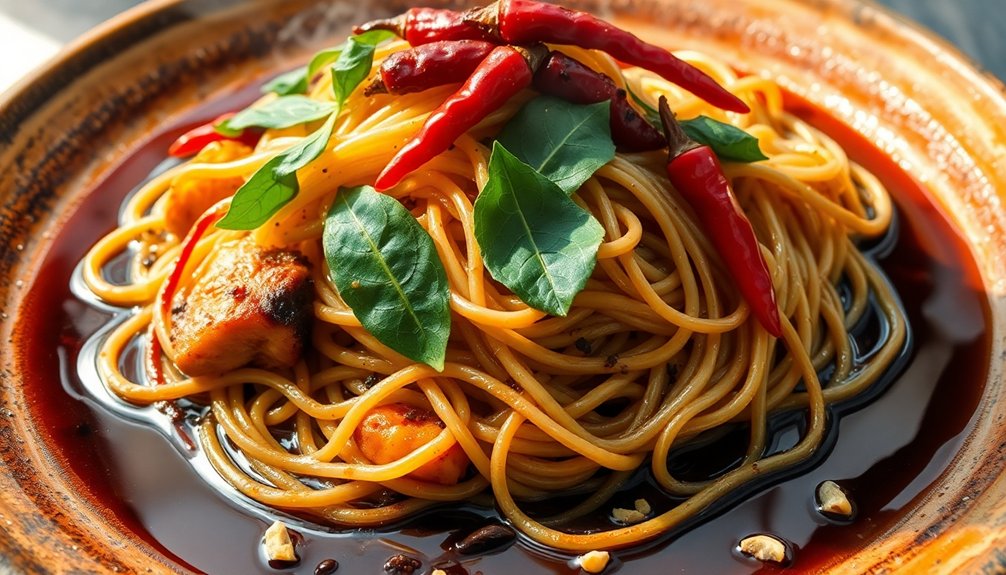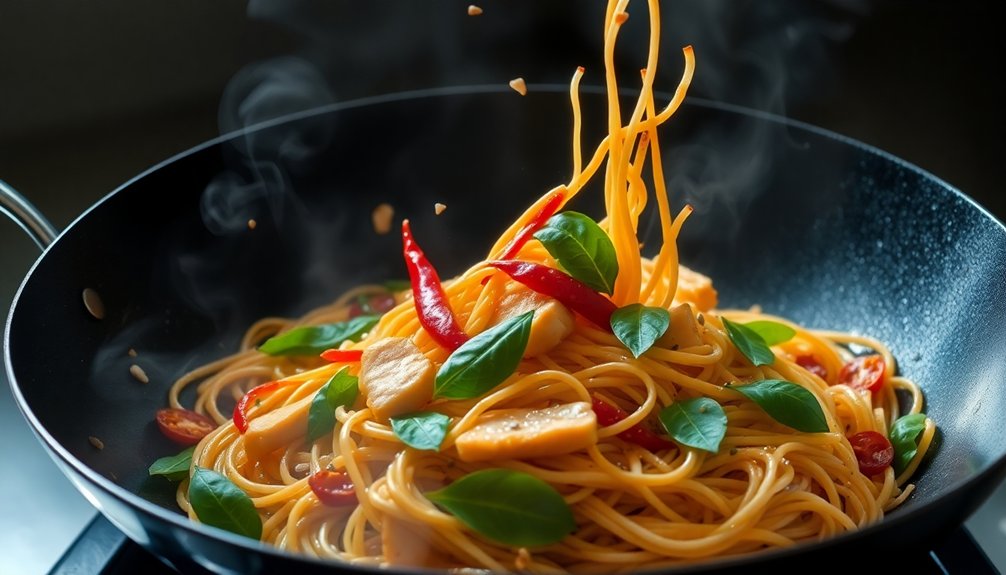How to Make Kway Teow Pad Kee Mao - Drunken Noodles
You’ll master these iconic Thai drunken noodles by stir-frying wide rice noodles in a smoking-hot wok with garlic, Thai chilies, protein, and vegetables. Mix in a savory blend of oyster sauce, fish sauce, and soy sauces, then toss until the noodles absorb the flavors. Finish with holy basil and lime wedges for an authentic street food experience. The secret lies in the wok’s high heat and your quick movements – let’s reveal the technique.
Key Takeaways
- Heat wok until smoking hot, add oil, then quickly stir-fry minced garlic and Thai chilies to release their flavors.
- Stir-fry protein and vegetables until cooked, maintaining high heat to achieve proper char and color.
- Add fresh wide rice noodles (kway teow) and sauce mixture of oyster sauce, fish sauce, and soy sauces.
- Toss ingredients rapidly over high heat until noodles absorb sauce and develop slight charring.
- Finish with holy basil and garnish with lime wedges and crushed chilies for authentic Thai street food flavor.
 History
History

Despite its relatively recent origins in the 1960s, Pad Kee Mao has become one of Thailand’s most beloved stir-fried noodle dishes.
You’ll find its roots in Thai cuisine’s adaptive nature, where Chinese rice noodles merged with intense Thai flavors and spices.
The name “Kee Mao” translates to “drunk,” and there are two theories behind this.
First, it’s said the dish was created as a late-night meal for people returning home from bars, with its spicy kick helping to sober them up.
The second theory suggests the dish is so spicy that you’ll need lots of beer to cope with the heat.
While its noodle origins trace back to Chinese immigrants, the dish’s fiery personality is distinctly Thai, showcasing the perfect marriage of two culinary traditions.
Recipe

Serves 4
Ingredients:
- 400g fresh wide rice noodles (kway teow)
- 200g chicken breast, sliced
- 4 cloves garlic, minced
- 2-4 Thai chilies, sliced
- 2 eggs
- 1 cup holy basil leaves
- 1 cup baby corn
- 1 cup bell peppers, sliced
- 2 cups Chinese broccoli, chopped
Sauce:
- 2 tbsp oyster sauce
- 1 tbsp fish sauce
- 1 tbsp light soy sauce
- 1 tbsp dark soy sauce
- 1 tsp sugar
Instructions:
- Mix all sauce ingredients in a small bowl; set aside.
- Heat oil in a wok over high heat.
- Add garlic and chilies, stir-fry for 30 seconds.
- Add chicken, cook until nearly done.
- Push ingredients to one side, crack eggs into empty space.
- Scramble eggs briefly, then mix with other ingredients.
- Add noodles, stir-fry for 1 minute.
- Add sauce mixture, baby corn, and bell peppers.
- Stir-fry until noodles are well-coated, about 2 minutes.
- Add Chinese broccoli, cook for 1 minute.
- Turn off heat, add holy basil.
- Toss until basil wilts.
Serve hot.
Cooking Steps

Start by heating oil in your wok until it’s smoking hot, then quickly sauté minced garlic and fresh chilies until fragrant.
Next, toss in your choice of meat and vegetables, stir-frying until the meat is cooked through and the vegetables are crisp-tender.
Finally, add the rice noodles and sauce mixture, tossing everything together until well-combined, then transfer to a plate and crown with fresh Thai basil leaves.
Step 1. Heat Oil in Wok
Pour a generous splash of vegetable oil into your wok and heat it over medium-high flame until you see the first wisps of smoke rising.
The ideal wok temperature should reach about 400°F (204°C) before you begin cooking your drunken noodles. You’ll know your wok is ready when the oil starts to shimmer and move fluidly across the surface.
- Choose oils with high smoke points like peanut, vegetable, or grapeseed oil – these won’t burn at the intense heat needed for proper wok hei.
- Test your wok’s readiness by dropping a single grain of rice – it should sizzle and dance immediately on contact.
- Move quickly once your oil is hot, as the wok temperature will continue to climb and you don’t want your oil to smoke excessively.
Step 2. Add Garlic and Chilies
With your wok now perfectly heated, toss in the minced garlic and Thai bird’s eye chilies simultaneously.
Watch as the aromatics sizzle and dance, releasing their essential oils into the hot surface. The garlic’s natural antimicrobial benefits combine with the chilies’ capsaicin kick to create a powerful flavor foundation.
You’ll want to stir quickly to prevent the garlic from burning while allowing it to become fragrant and golden – about 30 seconds is perfect.
For authentic heat levels, use 3-4 Thai bird’s eye chilies, though you can adjust based on your spice tolerance. If you can’t find bird’s eye chilies, long red chilies or even serrano peppers will work, though they’ll provide a different heat profile.
Keep the ingredients moving constantly to guarantee even cooking and prevent sticking.
Step 3. Add Meat and Vegetables
Once your aromatics have released their flavors, add your choice of protein – whether that’s chicken, shrimp, or thinly sliced beef – to the hot wok.
Cook your meat choices until they’re almost done, stirring constantly to guarantee even cooking and prevent sticking.
Next, it’s time to add your vegetable options. Thai basil, Chinese broccoli (gai lan), and bell peppers work wonderfully in this dish.
Stir-fry until the vegetables are crisp-tender, maintaining their vibrant colors and crunch.
- Keep your vegetables roughly the same size for even cooking
- Don’t overcrowd the wok – cook in batches if needed
- Push ingredients to the side of the wok when adding new items to maintain proper heat distribution
Remember to keep the heat high and your movements quick to achieve that essential wok hei flavor.
Step 4. Add Noodles and Sauce
Add your pre-soaked kway teow noodles directly into the wok, tossing them gently with your spatula to combine with the meat and vegetables. If you can’t find kway teow, substitute with wide rice noodles like ho fun or even standard rice noodles in a pinch.
Pour in your sauce mixture – traditionally a combination of dark soy sauce, light soy sauce, and oyster sauce. For extra heat, add Thai chili sauce or sambal oelek. Toss everything together over high heat, making sure the noodles don’t stick or clump. You’ll know they’re ready when they’ve absorbed the sauce’s rich color and start to char slightly at the edges. Some cooks add a splash of fish sauce or sweet soy sauce (kecap manis) for depth, but stick to the basic trio for authentic results.
Step 5. Plate and Garnish With Basil
Toss the fragrant Thai holy basil leaves into the wok during the final minute of cooking, allowing them to wilt slightly while retaining their aromatic oils.
You’ll want to work quickly to preserve the basil’s intense flavor and vibrant color.
- Transfer your drunken noodles to a large serving plate or individual bowls, making sure to distribute the proteins and vegetables evenly throughout the noodles.
- Add your garnish options: fresh lime wedges, extra basil leaves, and crushed red chilies for those who want more heat.
- For serving suggestions, pair your pad kee mao with steamed jasmine rice on the side, or serve it as a complete meal with an ice-cold Thai beer or lime soda.
Let the steam rise before serving, as the aromatics will intensify the dining experience.
Cooking Tips

Several essential tips will guarantee your drunken noodles achieve that perfect wok hei and authentic Thai flavor.
First, heat your wok until it’s smoking hot before adding oil – this prevents noodles from sticking and creates that signature charred taste. If you can’t find fresh rice noodles, dried ones work well, but soak them until they’re just pliable, not mushy.
For the best cooking techniques, stir-fry ingredients in batches to avoid overcrowding the wok.
When it comes to ingredient substitutions, swap holy basil with Thai sweet basil if needed, though the flavor will be milder. Can’t find Chinese broccoli? Use regular broccoli cut into thin strips.
Always have all ingredients prepped and within reach before heating your wok – this dish comes together quickly.
Final Thoughts

While mastering Pad Kee Mao takes practice, you’ll find it’s worth every minute spent perfecting your technique. The joy of savoring flavors from your own kitchen can’t be matched by takeout.
When you’ve mastered this dish, you’ll understand why it’s a beloved Thai street food classic.
- Perfect pairings include Thai iced tea, fresh coconut water, or a cold Singha beer to complement the dish’s spicy kick.
- Don’t be afraid to adjust the heat level – authentic Pad Kee Mao should make you break a sweat, but it should still be enjoyable.
- Consider growing your own Thai basil and chilies to guarantee you’ll always have fresh ingredients on hand.
Frequently Asked Questions
Why Is There No Alcohol in Drunken Noodles Despite Its Name?
Like fiery dragon’s breath, you’ll find drunken noodles got their name because they’re so spicy they’ll make you drink heavily, not from alcohol content. It’s a cultural origin explanation.
Can I Substitute Kway Teow Noodles With Other Types of Noodles?
You can definitely use other flat rice noodles when substituting noodles. Alternative noodle options like sen yai, pad thai noodles, or even standard rice noodles will work just as well.
How Spicy Should Authentic Pad Kee Mao Be?
You’ll find authentic pad kee mao quite spicy, as traditional spice levels pack a serious punch. It should make you sweat but still taste the other flavors clearly.
What’s the Best Protein Choice for Vegetarian Drunken Noodles?
You’ll get the best results with firm tofu that’s pressed and crispy-fried, but don’t overlook tempeh’s nutty benefits. Both options absorb the spicy sauce perfectly and add great protein-rich texture.
Can I Prepare the Sauce Mixture in Advance and Store It?
Like liquid gold in a jar, you can whip up your sauce mixture and store it for up to a week. The flavors will actually deepen and enhance during refrigerated storage.
